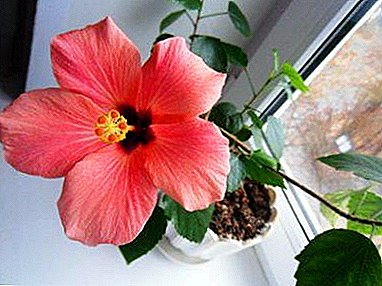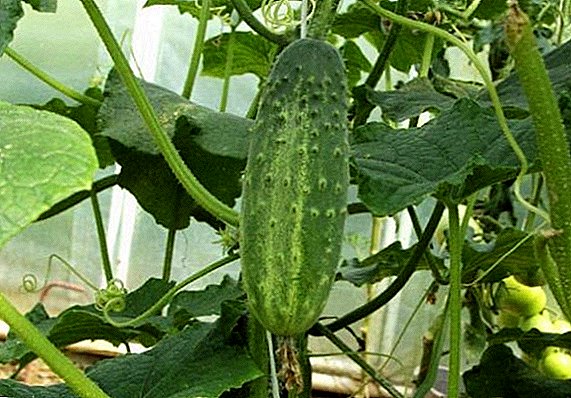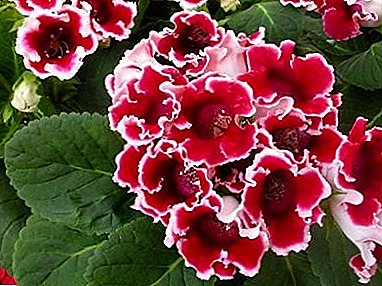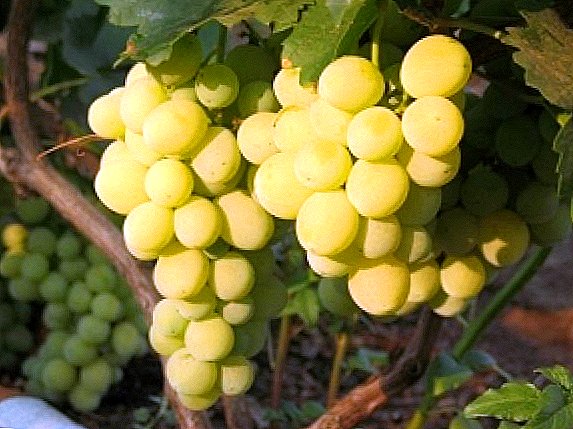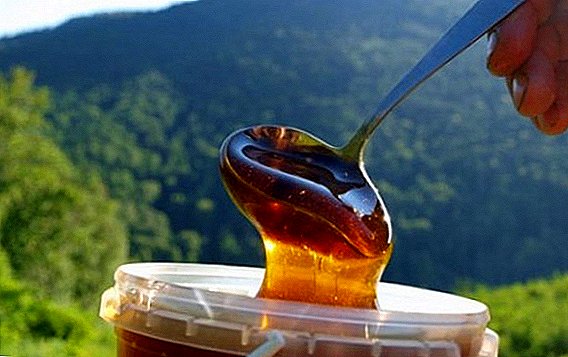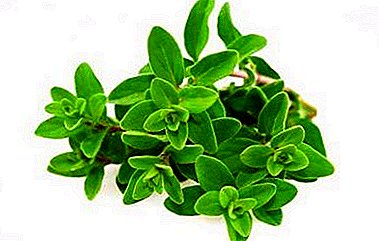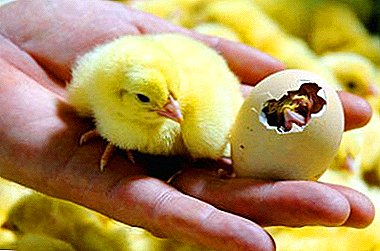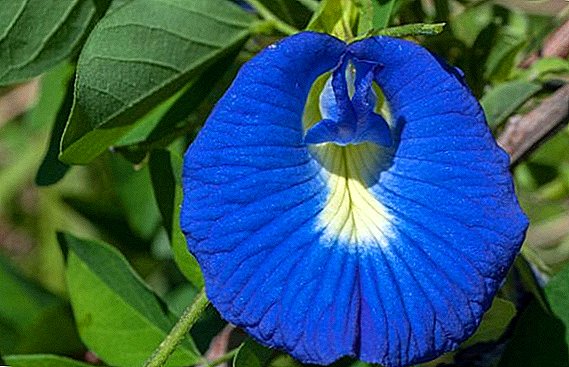 Flowers clitoria can be a beautiful addition to the landscape design. It is unpretentious, therefore, gained popularity among fans of ornamental plants.
Flowers clitoria can be a beautiful addition to the landscape design. It is unpretentious, therefore, gained popularity among fans of ornamental plants.
However, few know that this beautiful flower can be used as a tea or medicine.
In this article we will talk about the care, reproduction and application of clitoria.
Description
Clitoria is perennial evergreen vine, a variety of legumes, grows in tropical and temperate climates. Most species of this plant are climbers, although there are shrubs. The birthplace of this flower is Asia, and some species come from America.
 The name of the plant in Latin - Clitoria, translates as "clitoris", it was this part of the female body that the German botanist G. E. Rumef looked like a bud.
The name of the plant in Latin - Clitoria, translates as "clitoris", it was this part of the female body that the German botanist G. E. Rumef looked like a bud.
The British call this flower only moth peas or "pigeon wings", in Germany it is also called "shameless flower".
The length of the plant can reach 3.5 m. The grassy liana - this is how some sources call the clitoris - has an odd number of leaves that are located along the main graft. Their length reaches no more than 7 cm, the color range varies from dark green to bluish-green.
Did you know? Fresh and dried flowers of clitoria are used to decorate the holiday table.
The flowers of this plant are single, only in some species they can be collected in small inflorescences. The bud is formed in the leaf bosom, therefore it is also called the axillary flower, it has a tubular cup 1.5 cm long. The flowers of the clitoris are similar in shape to the inflorescence of representatives of the pea genus.
The corolla has a butterfly type and is formed from 5 petals that form the sail. The side lobes are called oars, and accreted lower ones - a boat. Together, they resemble a scallop. Bud size can reach 5 cm, and the color can be white, pink, lilac and with a shade of blue.  The color of the flower depends on the type of clitoria. Pollination is produced by insects that fly in for pollen. The flowering period of the moth pea lasts for 5 months (May-September).
The color of the flower depends on the type of clitoria. Pollination is produced by insects that fly in for pollen. The flowering period of the moth pea lasts for 5 months (May-September).
The representatives of this kind of legumes have flat fruit of the string form, the length of which varies from 4 to 13 cm.
The legume family has more than 20 thousand species, including beans, peas, peanuts, caragana, alfalfa, beans, clover, vetch, wisteria, acacia, lupine, dolichos, and broom.
Kinds
This kind of legume has to 70 representatives. For example, clitoris is white-flowered, narrow-leaved, annual, tree-like, Brazilian, dwarf and other species. The most widespread species such as the Atlantic and ternary (Ternatsky):
- The Atlantic "contraceptive flower" got its distribution in the USA, it grows in rare forests and bushes, the height of the creeper reaches 60 cm and has pale blue flowers, decorated with veins of a darker color in combination with bright yellow spots. This plant is not used in gardening, as it is poorly rooted in the new soil;
- trifoliate clitoria is well established in the tropical regions of Asia, where it is widespread. This variety of grass creeper is distinguished by thin shoots, which reach a length of 3.5 meters, and a blue flower in combination with a yellow center. The size of the flower in diameter reaches 5 cm.


This species has several decorative varieties: dark blue, purple terry, pale blue, blue and others. In our country, this type of vine is extremely rare. As an indoor or garden plant, you can buy the trifoliate Legenda clitoris. This is not only a beautiful flower, but also very useful. 
Plant Care
This type of vines is gaining more and more popularity every year. But if you decide to grow the clitoris in your garden or as a houseplant, you need to know the features of caring for it.
Familiarize yourself with the intricacies of caring for tropical plants at home: aphelandra, tillandia, albition, hypoestes, adiantum, cordilina, nepenthes, jacaranda, aglaonema, echema, azimine, longan.
Lighting
Clitoria is a flower of tropical regions where there is a lot of light and heat. In this regard, for its cultivation requires good lighting, and the room is better to put it on south window. True, it does not tolerate direct rays, so it is necessary to shade it in a hot period of time. For the summer period, the clitoris can be planted in the ground.
Important! If the flower will not receive enough light, then the buds will not form on it.
Temperature
The optimum temperature for clitoria ranges from +20 to +25 degrees. In winter, it tolerates temperatures well in the range from +12 to +15 degrees, but it should not fall below +10 degrees. In this regard, if you decide to plant a clitoris in your garden, for the winter you will need to dig it up and move it to a heated room.  When growing a flower in the indoor environment it is necessary to remember that he does not like drafts.
When growing a flower in the indoor environment it is necessary to remember that he does not like drafts.
The soil
Butterfly peas are planted in a loose substrate, which consists of a mixture turf, sand, humus and peat. To avoid overmoistening, it is necessary to use well-drained soil. Put in a perforated pot.
Read also about the types of soil and the use of peat as fertilizer.
Watering
Watering the clitoris is necessary regularlybut do not overdo it. For irrigation, it is better to use separated water at room temperature. In winter, watering is reduced to a minimum.
Humidity
The flower does not require special moistening of the air, but you can periodically spray it, which will be a prophylactic against pests.
Top dressing
Clitoria grows very well with regular fertilizer during flowering. In this regard, in the period from spring to autumn, it is necessary to lure a flower with mineral fertilizers once every two weeks. 
Pruning
When growing perennial clitoria species in the spring time, it must be cut and transplanted into a new larger pot.
The flower can be grown in the form of a shrub, for the formation of which young saplings are attached and give the necessary shape to the plant with the help of trimming. For climbing vines use a prop.
Breeding
Clitoria is propagated by cuttings and seeds.
Cuttings
For the reproduction of butterfly pea by this method, it is necessary to prepare cuttings from April to July. They root well, for this peat tablets can be used, loose soil with good moisture or sand. It is possible to stimulate the formation of roots by special means, but this is not necessary, since clitoria is well rooted.
Seeds
Sowing seeds begin in the last month of winter or in March. Before sowing, seeds are pre-soaked in warm water for 10-15 hours. Soak the seeds better in a thermos. After soaking, they are planted in the soil with a loose and nutritious base. Capacity with seeds covered with glass and left in a room at a temperature of + 21 ... +24 degrees with periodic soil moistening. Seeds begin to germinate 10–20 days after planting, but in some cases this period may take 4–5 months. Planted seedlings grown in the ground can only be in the warm season. 
Application
"Pigeon wings" are known not only for their beauty, but also for their beneficial properties. In Asian countries, this plant was used both for medical purposes and in cooking. Value represents all parts of the plant.
Drug use
The scientific community has been studying the beneficial properties of the clitoria only for the last decades, although in folk medicine it has been used for many centuries. Thus, the beneficial properties of the clitoria were known in ancient India. Its roots are used to create Ayurvedic preparationsthat stimulate brain activity.
Did you know? "Pigeon wings" is one of the main types of herbs that are used in traditional medicine in India.
All parts of the pea can be used to create cosmetics and medicines. On their basis, prepare a different tincture. Clitoria is used to male fertility treatmentsincreasing libido. Its use helps normalize the menstrual cycle among women.  A strong antidepressant is a decoction based on the flowers of clitoria. Antidepressant properties This liana was confirmed in modern studies:
A strong antidepressant is a decoction based on the flowers of clitoria. Antidepressant properties This liana was confirmed in modern studies:
- When treating pertussis, root powder is used.
- It can also be used to treat asthma of the bronchial type, cough and in various diseases of the throat.
- Clitoria root is used in snake and insect bites.
- The active substances that make up the plant, allow the use of moth peas decoction for the treatment of wounds.
- The use of decoction prevents the formation of pus and promotes healing.
- On the basis of this plant make pasta, the use of which helps to get rid of the discomfort with hemorrhoids. For constipation and ulcerative diseases of the digestive tract, clitoria seeds are used.
- Buds of the “flower of the flower” are used to make tea, which improves blood circulation in the fundus of the eye. Regular consumption of this drink reduces the risk of vision loss. It is a natural remedy for the treatment of glaucoma and cataracts. Clitoria is also used for making eye drops.
- Broths and extracts on the basis of clitoria help restore the hair follicle and stimulate its blood circulation. In cosmetology on the basis of this plant medicated shampoos are prepared.
It is interesting to read about the properties and application of tropical plants: chlorophytum, cassava, rambutan, pistachios, sweet potatoes, feijoa, pineapple, kumquat, chili pepper.
Clitoria is not a toxic plant, and therefore there are no contraindications for its use for healthy people. The only ones contraindications are individual intolerance, the period of pregnancy and lactation. You should also refrain from its use to children.
In cooking
Most often, the clitoris used in Thai cuisine. Blue flowers are used as a natural dye. The inhabitants of Asian countries with their help paint food, for example, sticky rice, which is a favorite delicacy of Thai people. Buds of the “flower” are fried in batter, and the plant is used as a seasoning.  On the basis of clitoria flowers, tea is prepared, which is known as thai blue tea. A wonderful drink stimulates brain activity, improves blood circulation. Very often, to add extra acidity, lime juice is added to tea. This additive gives the tea a purple hue.
On the basis of clitoria flowers, tea is prepared, which is known as thai blue tea. A wonderful drink stimulates brain activity, improves blood circulation. Very often, to add extra acidity, lime juice is added to tea. This additive gives the tea a purple hue.
Important! The most useful tea is blue tea, infused until the flowers are completely discolored.
Soups, side dishes and other dishes are made from the clitoria fruits. The process of cooking them is the same as for other legumes.
In landscape design
 Gardeners and designers use trifoliate or Atlantic klitoria as a decoration for the site. You can grow these plants in tropical regions and in temperate climates.
Gardeners and designers use trifoliate or Atlantic klitoria as a decoration for the site. You can grow these plants in tropical regions and in temperate climates.
In our latitudes, due to intolerance of low temperatures, it is grown in closed ground or in the open, but with a change for the winter time into flowerpots or tubs. Even this liana can be used as an annual plant.
With the help of clitoria you can decorate any part. It can beautifully move along the lawn or twist around the arch, and the shrub form perfectly fits into the design of your terrace.
Diseases and pests
This type of vines is resistant to most pests and diseases. The only danger for her is spider mite. Identifying this pest is easy: it is enough to carefully examine the plant. If it has a silver spider web or spots of light and dark color, then you should know that a spider mite has settled on the plant.
Check out the types of spider mites, as well as learn how to deal with spider mites.
If this parasite is found, it is necessary to take appropriate measures to combat it, otherwise the flower may die. For the fight, you can use special tools that are sold in any flower shop, or increase the number of sprays.
If the plant was in the open air, then before bringing it into the room, it is necessary to treat the green part with insecticide. This tool helps to get rid of harmful insects.  This representative of legumes is not particularly capricious, and due to its rapid growth and long flowering period, it is an excellent addition to the room collection or in the garden. The clitoria inflorescences are used to make tea or spices, and its beneficial properties have made it an indispensable drug in Asian countries. Every year these medical traditions are spread all over the world, which allows using the clitoris not only in traditional medicine, but also in cosmetology.
This representative of legumes is not particularly capricious, and due to its rapid growth and long flowering period, it is an excellent addition to the room collection or in the garden. The clitoria inflorescences are used to make tea or spices, and its beneficial properties have made it an indispensable drug in Asian countries. Every year these medical traditions are spread all over the world, which allows using the clitoris not only in traditional medicine, but also in cosmetology.


